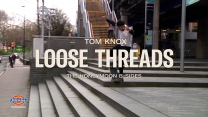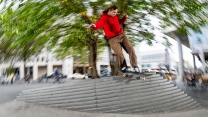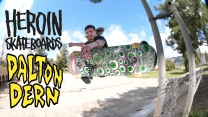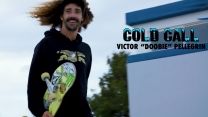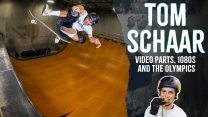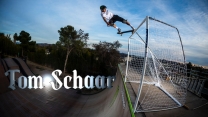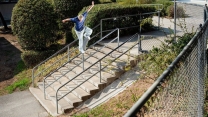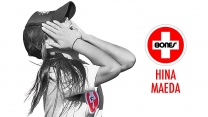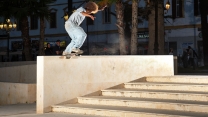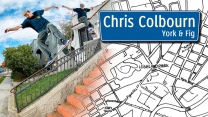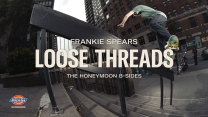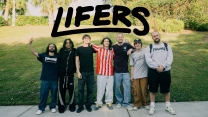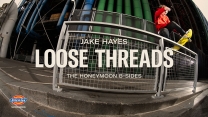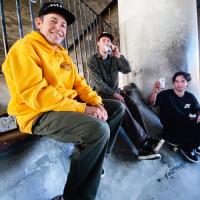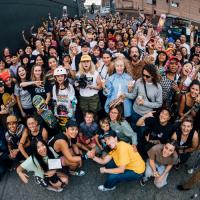Natalie Porter and the Womxn Skate History Project
6/02/2025

Women skating ain’t somethin’ new, but if you only had videos to look back on, you’d be hard pressed to prove it. Before we had a somewhat diverse array global stars like Nora, Leo, Lizzie, Rayssa and Samarria, most of them were just doin’ it for the love, with little documentation—and no money. Thankfully, a Canadian librarian has done the digging to catalog and record the history of women and trans skaters from the early days up to the present. Natalie Porter’s aptly named Womxn Skateboard History is one of those rare internet resources that is as useful as it is intriguing. On the eve of her upcoming book, Burnett got Natalie on the line to riff on early skate memories, common myths of the ’80s and the profound impact of the mag’s first woman columnist Bonnie Blouin.
 Rebecca Burnquist on the cover of Villa Villa Cola issue 5, 1999
Rebecca Burnquist on the cover of Villa Villa Cola issue 5, 1999There’s a lot of stereotypes about skateboarders. Are there any stereotypes about librarians you’d like to dispel here?
I embrace them totally. I love the stereotypes: I am organized; I am obsessed about finding answers. I fully embrace my librarian identity. So no, I don’t dispel it, but I think we often do have secret identities, and people are kind of shocked when they find out that I’m a skateboarder. So there’s usually more to us than meets the eye. It’s not just the top bun and glasses, right?
How did your two passions of skating and library science combine?
I’ve been skating since ’95 after I found my big brother’s Rob Roskopp in the closet. So I’ve been skating for a while, and then I was motivated to go to Montreal to do a master’s degree and ended up writing this thesis paper on female skateboarders and space and identity. That was like 2003. Pretty soon I realized I probably wouldn’t be able to get a job with that thesis. It was pretty random for that time. So I went back and got my librarian degree and had been hoarding zines and interviews and magazines, just kind of accumulating stuff, thinking, Yeah, maybe I’ll put out a book someday. I wanted an outlet. And I love research, so I kind of combined those skills together to produce the archive in March 2022.

What are some common myths you encountered about the history of women in skateboarding?
There’s the classic myth that skateboarding in the ’80s was too punk or hardcore for women to really thrive. And there’s some validation for that. There was some hostility towards women skating in the ’80s. It was really branded as this domain for guys to prove their skill and masculinity, but at the same time, there’s always women thriving. We just went underground, really. There are some pretty cool zines that came out of the ’80s. Bonnie Blouin, obviously, who is massive and someone I revere, had her own column in Thrasher, and was doing her own thing. And that trend sort of continued through the ’90s until the Internet, really, when we could finally see each other and connect more easily. But women have always been involved––whether it was pen pals or zines or making their own contests and stuff. But I understand why it seemed like there weren’t very many women. Even the women themselves will tell me, Oh, I was the only girl. And you have to bring context in, because maybe you were the only one in your community, but there could have been someone practicing alone in a tennis court. It may have seemed like they weren’t out there, but they were definitely out there.
 A small sample of the zines that hold our history
A small sample of the zines that hold our historyTalk about the role of zines in women’s skate history.
My obsession with zines is because they are primary documents and have the most candid stories of what it was like, say, being forced to compete against dudes in the 1980s when there were no categories for girls. They are first-person accounts. Zines were creative ways to network with each other. For example: KZ Zapata did Push, Push, Then Go. She was sponsored by SMA and anytime she met another girl, she would use her zine to make connections. Get their address, become pen pals, and generate that action. And then the zine Equal Time was really the catalyst for The Women’s Skateboard Network. They were saying by 1992 they had a circulation of 1000 and 250 members, which is pretty epic for a zine in the late ’80s/early ’90s. That’s a lot of women skaters. And then that resulted in the video SK8HERS, which came out in ’92 and had 14 women in it. Yeah, there’s these DIY efforts that are ongoing, which are really cool.
 Armpit Zine #3
Armpit Zine #3For people who haven’t seen it, you’ve created this online archive of women skaters from the ’60s to the 2000s. What would you say is the mission of the Womxn Skate History project?
I want to validate older women in skateboarding, mostly, just that they’re remembered and celebrated and it gives me a lot of fulfillment. I didn’t plan on doing any interviews. I’m technically a bit of an introverted librarian, but I realized like, Oh man, there’s nothing out there. I have to track this person down. And they’re just so stoked. It’s amazing. They’re so excited. And I’ve kind of created this really cool community. I’ll give props to Kevin Marks and The Look Back Library. There have been many older skaters and collectors who’ve helped me track this stuff down. Like, this guy in England is going to send me the fourth issue of Equal Time. It’s got Frankie Hill on the cover, and I’ve never seen it! I thought it was lost forever. And so he reached out; he’s going to send it to me. So I get a lot of joy and connection out of that, and it keeps me entertained.
What’s the criteria to be included?
I’m open to women and non-binary skaters. Like Terry Lawrence actually wrote to me, and I wasn’t sure if he wanted to be in the archive. But he was like, You know, I want to be recognized as a female pioneer. My pronouns and identity have changed, but I still want to be remembered. I was like, Check, yes, you’re totally in, yeah. So really, if you’ve participated, competed, yeah, it’s pretty loose. I’m not a real stickler. Photos definitely help.
Let’s talk about research a little bit. A lot of what people consider research doesn’t seem to go much past Google, so we see the same stories and the same images and the same research coming up again and again, and some of it is wrong or not that great. What does real research look like to you, and what are the challenges of researching something as niche as skateboarding?
Yeah, you gotta dig deep. And you kind of have to be creepy sometimes, at least in my case. I use Facebook a lot. There are not a lot of interviews out there, so a lot of times all I’ve got is a name, so I check Facebook. I’m also using my library access to university databases and newspaper archives. There’s so much cool stuff out there. Sometimes you have to get a little technical, use some keywords to dig it up, but yeah, if you just make that little extra effort, and even hit up your local library, sometimes you’ll find something really special. In my case, it’s also an added difficulty that some of the older women’s last names have changed. So I’m always trying to think of innovative ways to figure out who they are or where they are. Sometimes it’s not skateboarding that I’m even looking into, it’s surfing or snowboarding or motorbiking in one woman’s case. I’ll find a lead and go from there. Also, there are a lot of spelling errors in skateboard magazines, so sometimes you have to search under several different possible spellings of a woman’s name. You have to get kind of creative on how to find them. Social media is a game changer, for sure, especially Facebook.
 Photo: MOFO
Photo: MOFOYeah, the older crew really loves Facebook. Is there a researching miracle or bit of luck you can tell us about?
Oh, yeah, there’s Georgina Matthews in New Zealand. She’s a Maori skater, part of the Gallaz team and was in their video AKA: Girl Skater. And I really wanted this footage of her that had been on a Maori skateboard TV network, and I knew University New Zealand had that footage in their collection. But there was so much red tape, like, they were really trying to prevent me from getting access to it. So I went on LinkedIn, and I tried to find all of the cool looking librarians that worked at that university, and I wrote to all of them. And it was a battle. And then finally, a skateboarding librarian in New Zealand who was Maori, heard about it, found out about it, and was like, We have to get access to this footage. We found the defunct company who produced the video. It was insane. I actually wrote about it in my book because, it’s, like, this is what we live for! It’s literally two three-minute clips, but it’s her being interviewed by her peers and her friends, and it’s just gold. I love that stuff.

 True Devotion Vol. 2 No. 5 by Bonnie Blouin
True Devotion Vol. 2 No. 5 by Bonnie BlouinWhat are some stories or people you’ve discovered or learned more about that have really had an effect on you?
Oh, well, yeah, with the Bonnie Blouin story, I didn’t know how she passed away. I didn’t know she’d died by suicide when I first started digging into this, and that was really, really intense. I was obviously pretty gutted about that because she means so much to me. She’s very special. And actually, I own two handwritten letters from Bonnie that were written to Thrasher in 1986 and they are my most prized possessions. They’re so cool. Yeah, so she’s obviously special as the first female journalist for Thrasher … I’m gonna get emotional. But there’s been all kinds of interesting stories and discoveries. Like, it’s almost daily I get these messages, you know, sometimes I put up a post and there’s still kind of a mystery. I can’t find them, and then, like, two years later, I’ll get this email like, That’s me! and I’ll interview them. They’ll Google their name in the middle of the night, which happened with this one woman, Pam Judge, who was the first Canadian national champion from 1978. I couldn’t find her because she’d changed her name. Her name is PJ McKenzie now. She Googled her name, wrote to me, and I actually went and visited her, because it was such a cool connection. So every week, there’s some strange miracle piecing things together. It keeps me motivated, for sure. And sometimes I’ll go into an interview thinking I know the story already and be completely blown away. Like there was this one woman, Beth Fishman, and I’m like, Oh, I read about her. Her brothers introduced her to skateboarding. She did a contest, beat all the boys. I thought I could predict what she was going to talk to me about, and then she just laid down the coolest stories ever, like how she met Patti Smith. She hung out with Patti Smith for the day as an 11 year old! I’m just in awe of all these women. So far I’ve been really fortunate. They’re all just so cool.
 Bonnie Blouin, 1987 Photo: KT
Bonnie Blouin, 1987 Photo: KTI know when I get around some of the older guys, they each have a different version of the same event, or a different version of the details. How important is getting to the truth with your project? How important is accurate information?
Yeah, that’s actually a tricky one, because that’s happened before where one person thought that they were the first to have had this experience, or been the first to have done something as a female skater, and I discover, like, Oh, actually, maybe not. My approach so far is that I’ll correct the website as best as I can, but I’m not gonna necessarily call them out or be a fault finder. I don’t want to shame anyone. So yeah, as the librarian, I’ll probably just avoid it. I’ll do my best to share the different truths.
 Amelia Bjesse Puffin's Smash the Skatriarchy Vol. 1, 2020
Amelia Bjesse Puffin's Smash the Skatriarchy Vol. 1, 2020I find that a lot of older people I interview are kind of actively assessing the story of their lives. Are they the hero? Are they the victim? Do you find a lot of people trying to write their life stories one way or another when you interview them?
I have. This is interesting. This is a part of this work that I hadn’t totally anticipated. But a lot of the women have recognized that I’m a listening ear and will tell me their #metoo story. They’ll tell me a story where they may have been a victim. It’s been really hard. It’s actually been an interesting kind of healing process for me. Because you hear about the ’70s as kind of the glory days, but there’s this flip side, like with any community. So that’s been an interesting result of doing this work.
 Cara-Beth Burnside, 1981 Photo: KT
Cara-Beth Burnside, 1981 Photo: KTI wasn’t even really thinking about it like that, but that’s an even more significant issue.
It’s thought provoking. They want to tell their truth, and they don’t necessarily want to shame someone. They’re not looking to take it further, but they want to talk about it, and they want to see change in the community. And they also do want to feel like a champion. They’ve overcome adversity, and I’m here for them. I’m here to tell their story as much or as little as they want, and just say, I hear you and you’re valid, you’re important.
That’s a heavy one. I was just thinking about dudes arguing about who should have won the ’77 World Championships or whatever, but what you’re dealing with is a lot more consequential.
It’s a little bit different spin on it, but yeah, it’s been interesting.
All media has experienced a meteoric shift with the dawn of social media. What are the opportunities and challenges of covering skate history now that it has been decentralized?
Well, I’ve always found it to be a positive thing, like, really you can represent or market yourself, if that’s what you want to do. If you want to become a brand, you can do that. And there’s just so much content. I actually feel like I have to kind of cap myself at maybe 2010 because after that, it really does get quite diverse. But, yeah, it’s an exciting time. And I think there’s just more voices and diversity overall. I think it is really quite positive, and people can do some creative things with their own magazines, their own companies. And, yeah, hopefully mostly positive. Having all that info is great. Like, I can find some cool information about a crew in Brazil in the ’80s, the Anarquia Team, which had a bunch of pretty punk, badass women. There’s little pockets around the world, which is kind of manageable for me to explore. But yeah, once the new millennium came, it’s a bit overwhelming.
 Girls Who Grind Zine by Lynn Kramer, December, 1988
Girls Who Grind Zine by Lynn Kramer, December, 1988I never really thought of myself or my friends as good enough to be in the mags, but that was the same kind of thinking that largely excluded women from the mags for the last 30 years. You needed to be “as good as the pros” for the most part. Now that everyone can put themselves out there, what does recording history look like moving forward? What makes someone worth remembering 20 years from now? Their number of followers?
I think about it. Some of these average, ordinary skaters I’m still going to include. But strange enough, I do have Thrasher to thank, even in the old days, because they always published the letters from women. The visual representation was a bit lacking, but there was no censorship or anything of the letters, and they’re freaking hilarious! They’re gold! During the Riot Grrrls era a lot of women wrote in and they’re really mad. I love it. And sometimes they even ended up making their own zines. Like Ramdasha Bikceem wrote to Thrasher, You’re not representing me! I’m gonna make my own zine. And then they did. It was called Gunk, and they were just a badass Riot Grrrl band and zine and crew. And it’s all because of Thrasher publishing those angry letters. Props to Thrasher for doing that. There were also women in the music section, like, there was a review on The Frumpies in the ’90s, which is another Riot Grrrl band, so they were included in the magazine. So women may not have been at the forefront, but I could still find them. I could still find hints and breadcrumbs that are leading me to other resources.
 Bonnie Blouin's Sugar and Spice article from our April 1986 mag
Bonnie Blouin's Sugar and Spice article from our April 1986 magSo we didn’t completely blow it. That’s good to know. Tell us about your upcoming book.
It’s called Girl Gangs, Zines and Power Slides: a history of badass women skateboarders. It’s on ECW Press, out in September 2025.
 You can pre-order Natalie's book here
You can pre-order Natalie's book hereCongrats! You mentioned Bonnie Blouin. Who are you other heroes in women’s skateboarding?
Oh, Lisa Whitaker. Oh my gosh, she’s like a guardian angel. She was skating in the ’80s and ’90s, and then started to film a lot of women in skateboarding, and was on Rookie and then, once the Internet came around, she created The Side Project, which then became The Girls Skate Network website. That is just a real hub, you know—interviews, blogs, video blogs. And she was also connected with Villa Villa Cola, the zine that was out of San Diego, and together, they made the video Getting Nowhere Faster in 2004 which was just such a game changer. You know, Vanessa Torres, Amy Caron, like so, so amazing. And then, of course, now she runs Meow and just supports a lot of skateboarders who would never otherwise, maybe have a board sponsor. So, yeah, Lisa, she’s the best.
 Nora Vasconcellos and Lisa Whitaker, 2025 Photo: Burnett
Nora Vasconcellos and Lisa Whitaker, 2025 Photo: BurnettWhat else?
Maybe something about Slow Impact? Last year I went for the first time, and I was pretty nervous, because I’m quite isolated. I live up north of Vancouver in Canada, and I’m coming down to Tempe, and there’s a lot of guys there, but there were some women and non-traditional skaters too. But I was really nervous. And then I did this presentation on ’80s and ’90s zines, and everyone was so encouraging, like, super nice, asking thoughtful questions, and were really engaged. And then there was just such a diversity of other sessions and panels like sobriety and the situation in Palestine. I was so blown away by the whole event, and I’m heading back down this year to do a little sneak peek of the book. I’ll be reading with Kyle Beachy’s session and I’m on this panel on journalism and accountability in journalism, so it should be really fun. But yeah, it was such a highlight for me last year to feel like I could be part of a community of really thoughtful people. I’m excited to go again.
 Speaking on the skate journalism panel at Slow Impact, 2025 Photo: Schmitz
Speaking on the skate journalism panel at Slow Impact, 2025 Photo: SchmitzLast question: Have you read any good books lately?
I just read a memoir by Rebecca Solnit called Recollections of my Nonexistence that includes her years as a punk feminist writer in the 1980s living in San Francisco. I cried at the end, it was so good.
 Audiences in Tempe, AZ got the first hit of the new book. Pre-order it, check her site and update that list of favorite skaters with the rich catalog Natalie's put together for you Photo: Schmitz
Audiences in Tempe, AZ got the first hit of the new book. Pre-order it, check her site and update that list of favorite skaters with the rich catalog Natalie's put together for you Photo: Schmitz-
Wheels of Fortune 12 Photo Recap
After a year off, the ultra-inclusive global scene ascended on Seattle to celebrate the 12th iteration of the blockbuster event series. With figures like Elissa, Marisa, Leo, Marbie and Nora, the entire weekend brought unprecedented hype. See it all here. -
Burnout: Peter Hewitt Weekend
The Antihero team descended into San Diego to rip it up and help celebrate the awesome force which is Peter F—in’ Hewitt. A few grinds, a few laughs and a big blow-out photo show with a special video and musical guest made this bash one for the history books. Who should we celebrate next? -
Una Farrar's Pro Surprise Photos
Canadian legends, pioneers of the women's scene and the Krooked team marched down to Frogtown to give Una her flowers. See all the Tubsy heads in attendance. -
Wheels of Fortune 11 Photo Recap
Touted as “the Coachella of non-traditional skateboarding,” Wheels of Fortune 11 drew more than 300 skaters to partake in a weekend packed with pro surprises, goose chases, karaoke, contests and pure joy. Get a glimpse of all the mayhem with this stacked recap. -
Nora Vasconcellos: People I've Known
Both Nora's skating and her fun-loving, off-board enthusiasm for life have gravitated many characters into her orbit. Here are a few of them.
